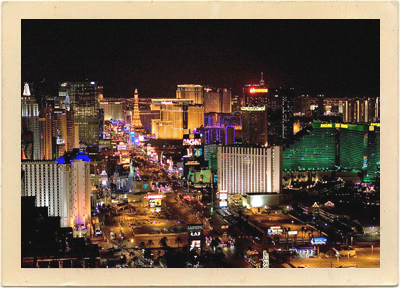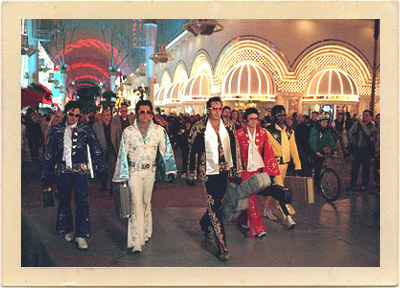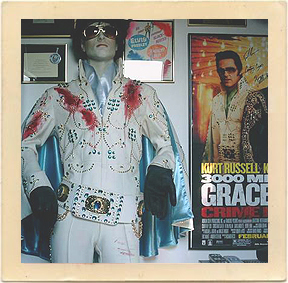 |
|
 3000 Miles to Graceland 3000 Miles to Graceland2001. Warner Brothers, Warner Home Video, Color, Aspect Ratio 2.35 : 1, 125 minutes, Rated R Release Date: June 24, 1994 3000 Miles to Graceland is available at Amazon.com on DVD and VHS. Movie Synopsis: A con man and four accomplices storm a Las Vegas casino during an Elvis impersonator convention for a $3.2 million robbery that turns into a haywire bloodbath: partners are eliminated, double-crosses abound, and then things get really nasty. ~Aimee Cast: Kurt Russell, Kevin Costner, Courteney Cox, Christian Slater, Kevin Pollack, David Arquette, Jon Lovitz Director: Demian Lichtenstein Thoughts on the Movie: Now first... this movie is not about a bunch of Elvis impersonators, nor is it about Graceland. What is about is a lot of action and violence that only works as good entertainment because of the two stars, Kevin Costner and Kurt Russell. Actually, I saw the action and violence as sort of tongue-in-cheek and over-the-top, so I didn’t take it seriously. Another reviewer described it as “a kind of absurd in-your-face exhilaration.” And that’s why I like this movie. Kevin Costner plays one heartless, bad-ass dude, but, hey, maybe this twisted, completely screwed-up guy is Elvis’ illegitimate son... and isn’t that somewhat intriguing? For me, the icing on the cake of this film is Kurt Russell in full Elvis jumpsuit mode, lipsyncing to Such a Night over the closing credits. That alone is worth the price of admission. The best Elvis impersonator and probably the best Elvis song (without a doubt, the coolest Elvis song) rolled up into one. Good God! Such an experience! ~Jean Location Site: Nelson, Nevada (see Map) Naturally, many scenes in 3000 Miles to Graceland were shot in Las Vegas, but some scenes were shot in more remote desert areas outside the city, one of those being in the nearby town of Nelson. Seven scenes were shot here, including the Texaco gas station (where they blow up the plane) and dropping the body from the helicopter. The gas station has since burned down, but the other buildings are still there. If you like prowling around old buildings, rusted-out and antique cars, and old road and gas station signs, this ghost town is the place for you. About Nelson, Nevada: Nelson, Nevada (population 56; elevation 2,201 feet; 35° 27’ 58” N, 114° 55’ 38” W) is located on US 95 about 25 miles southwest of Las Vegas. Nelson is an unincorporated community in Clark County, in the Las Vegas metropolitan area. It is in the southeast region of the Eldorado Valley in Eldorado Canyon. Nelson is upsteam about 16 miles from Lake Mojave. One of the biggest mining booms in state history occurred near here, in Eldorado Canyon, when gold and silver were discovered around 1859. In fact, the town was named for Charles Nelson, a prospector who was slain at his mine in 1897. Nelson’s Landing, about five miles west in Eldorado Canyon, is noted for washing into Lake Mohave in 1974, after a strong downpour in the regional mountains sent the runoff down the channels, producing a flash flood. There are five wide channels that run from the local mountains toward the river and they all converge into a small outlet where Nelson’s Landing once was. The entire landing and village was destroyed, and nine people died when the flood came through the wash. The wall of water and debris was reported as nearly 40 feet high as it reached the river. Much of Nelson, which was not impacted by the 1974 flood, remains today and is located way up the wash, away from the flood channels. The sparsely populated community consists mainly of privately owned ranch houses, and a river and mining tour business housed in a former Texaco gas station, that has been used as a filming location for several feature films, including 3000 Miles to Graceland.  About Las Vegas, Nevada: About Las Vegas, Nevada:Las Vegas, Nevada (population 583,756; elevation 2,001 feet; 36° 0’ 0” N, 115° 0’ 0” W) is located in the southeast corner of the state at the junction of US 95 and I-15. Established in 1905, Las Vegas officially became a city in 1911. With the growth that followed, by 2001, Las Vegas had become the largest American city founded during the 20th century. The city’s tolerance for various forms of adult entertainment earned it the title of “Sin City,” and this image has made Las Vegas a popular setting for both films and TV shows. The name Las Vegas is often applied to unincorporated areas that surround the city, especially the resort areas on and near the Las Vegas Strip. The 4.2 mile stretch of Las Vegas Boulevard known as the “Strip,” is mainly in the unincorporated communities of Paradise and Winchester, while a small portion overlaps into Las Vegas and the unincorporated community of Enterprise. Right: The modern-day Las Vegas strip area, lit to capacity in 2001. Las Vegas started as a stopover on the pioneer trails to the West, and became a popular railroad town in the early 1900s. It was a staging point for all the mines in the surrounding area, especially those around the town of Bullfrog, that shipped their goods out to the rest of the country. With the proliferation of the railroads, Las Vegas became less important, but the completion of the nearby Hoover Dam in 1935, resulted in the growth of residents and tourism. The legalization of gambling in 1931, led to the building of the casino-hotels, for which Las Vegas is most famous. The success of these early casino businesses came from American organized crime. Most of the original large casinos were managed or at least funded under mob leaders Benjamin “Bugsy” Siegel, Meyer Lansky, or other mob figures at this time. With the arrival in the late 1960s of millionaire mogel Howard Hughes, who purchased many of the existing casinos (as well as television and radio stations in the city), legitimate corporations began to make similar purchases. The mob was run out by the federal government over the next several years.  Right: The heist gang in “3000 Miles to Graceland,” make their way through the crowded streets in front of the large casinos in Las Vegas, Nevada. Right: The heist gang in “3000 Miles to Graceland,” make their way through the crowded streets in front of the large casinos in Las Vegas, Nevada.Today’s Las Vegas, with its gigantic entertainment-hotel-casino complexes is nothing like the Vegas of the mid-20th century. The majority of the historic old landmarks from that part of American history are gone. Local Attractions: El Dorado Canyon Museum and Mine Tours Owned by Tony and Bobbie Werly, the small museum is the major stopping off place in Nelson. They also operate tours of the old Techatticup Goldmine and kayaking or canoe trips in nearby blue water coves. Hoover Dam and Lake Mead Hoover Dam, located 30 miles southeast of the Las Vegas, also formed Lake Mead, America’s largest man-made lake and reservoir. Lodging & Dining: The nearest lodging and restaurants are in Boulder City, Nevada, approximately 25 miles north of Nelson. Of course, staying in Las Vegas and enjoying everything it has to offer is also an option. Filming Info: Nelson, Nevada, is used as a location for many movies, both major productions and independent films. Of special interest to production companies is the Techatticup Goldmine, which is often used in low budget films, such as vampire movies, etc. 3000 Miles to Graceland shot in Nelson for one month. Movie Trivia: • Kurt Russell made one of his early screen appearances in the Elvis Presley movie It Happened at the World’s Fair (1963) and later played Elvis in the TV-Movie Elvis (1979) directed by John Carpenter. He also provided the voice of young Elvis in Forrest Gump (1994). • The plates on the red Caddie read 3KMTG (3K = 3000, M = Miles, T = To, G = Graceland). • Throughout the movie, Kurt Russell’s character is seen wearing a necklace. The necklace is “TCB” with a lightning bolt. “TCB” stands for “taking care of business,” which was Elvis Presley’s slogan. He gave similar necklaces to his entourage, the ”Memphis Mafia.”  • Tony and Bobbie Werly owned the gas station, as well as the barn and other buildings seen in the scenes shot in Nelson, Nevada. They give tours of the location, including the Techatticup Goldmine, where quite a few movies have been shot. Techatticup is a Paiut word which means “I'm hungry.” As it happens, when the Indians originally showed miners where to mine for gold, they kept saying “I'm hungry,” and the miners ended up giving the mine that name, because they thought that’s what it was called by the Indians. • Tony and Bobbie Werly owned the gas station, as well as the barn and other buildings seen in the scenes shot in Nelson, Nevada. They give tours of the location, including the Techatticup Goldmine, where quite a few movies have been shot. Techatticup is a Paiut word which means “I'm hungry.” As it happens, when the Indians originally showed miners where to mine for gold, they kept saying “I'm hungry,” and the miners ended up giving the mine that name, because they thought that’s what it was called by the Indians.• There was a large Coca-Cola sign on the barn in Nelson, before a scene for 3000 Miles to Graceland was shot, which would include the barn in the background. The producers told the owners of the barn that they would have to remove the Coca-Cola sign, because Pepsi was going to sponsor the movie. Once the sign was removed, the producers came back to them and said, “Pepsi’s out, and Coke’s in, so put the sign back up.” You can just get a short glimpse of the sign on the barn in one of the scenes shot during that time. Right: The jumpsuit Kurt Russell wore in “3000 Miles to Graceland,” is now on display with other memorabilia from the 2001 film. Character Quote: “Guys like me die caught. Guys like you die bloody.” ~Michael Zane (Kurt Russell) |
|